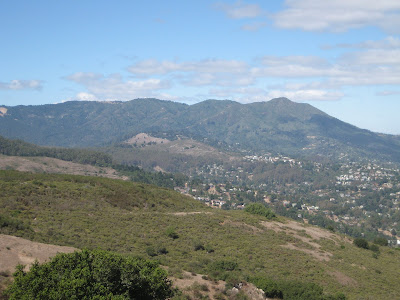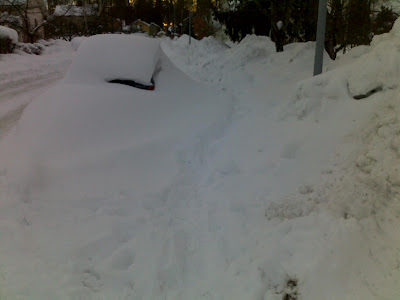So, after watching some 5 movies (they were all very good) on a tiny screen in an aeroplane, there I was, in San Francisco, where the disciples, or possibly, descendants, of Gary Fisher display their mad skills by doing long wheelies in front of Alcatraz:
And, first of all, I gotta tell you, Finland is a developing country when it comes to bicycling as a form of traffic. In San Francisco they have it much better. For instance, SF drivers, in general, don't try to kill bicyclists in traffic. They don't act like jerks. They stop in intersections and let bicyclists go first, if they have the right of way. In SF, the bicyclists ride on bike lanes or among the traffic, and they are mostly treated with respect. It's not scary riding a bike there.
Anyway, after renting a bike (from Blazing Saddles), I headed for Marin County. I was kind of aware that to get there, you have to cross the Golden Gate bridge:
After crossing the bridge, I was faced with the fact that I really should've taught myself to use the Garmin 705 bike computer I had borrowed from a friend for the journey earlier. But based on what I'd like to call an internal compass, and some might call blind luck, I did find a trailhead:
The bike: Marin Mount Vision 5.8. Not a bad bike. The one I had had a couple of flaws: a freehub that tended to stick and make a noise on descents, and a seat post that kept sliding down. And just like the guy told me at the rental shop, the bottle will get very dirty in the holder.
The terrain was mostly fire road, i.e. technically easy, dry, sandy road. The hard part was all the climbing - I'm not really used to having to climb for tens of minutes at a time on granny gears to get on a hilltop. In southern Finland, the hills are really minuscule compared to these real ones.
There was some singletrack as well, but it was technically easy as well. Where's all the mud, roots, rocks and trees? Is this really mountain biking?
In the distance there's Mount Tamalpais, on top of whiche the shrine of Gary Fisher resides in, if I'm not mistaken. But that's for the next day.
There seems to be some not too bad apartments on the hillsides as well. I guess one could live here for a while, if absolutely obliged to to do so.
This is what the typical climb looks like. And it goes on and on. And, for an albino such as yours truly, there was more than enough sun as well. BTW, notice the writing in the sky. There was an air show over SF. Can't tell what it spells though.
After some 6 hours of bicycling, there's Golden Gate again. And there are some significant hills in the city as well. Ok, I admit it: I had to push the bike on some of the steepest hills on my way to the hotel.
There's nothing like pizza after a day of mountain biking. Ok, there is. It's beer. But one wouldn't suffice without without the other. So, I think we all can agree that the perfect combination of sustenance and refreshment post-bicycling is pizza and beer.
The hotel didn't have a special safe bicycling holding space so I just kept the bike in the bathroom. Did I mention yet that I was going to ride for two days?
Although perhaps sadly lacking in mud, the Bay Area makes up for it in dust:
Those aren't leggings, I tells ya. Some of it might be tan line, though.
So, the next day, to conquer Mount Tamalpais, and to find the holy shrine of Gary Fisher they keep telling me about. In reality, it wasn't really this misty. I must have breathed in the camera lense or something.
Now, between these two pictures there's an inpicturable period of pain that includes finding the trailhead in a nice-looking suburban neighbourhood, and then climbing up hillsides for some 70 minutes straight. I'll always be looking back to that pain with yearning.
On the mountain top, I finally found what I honestly believe was the shrine of Gary Fisher:
And let me tell you, a can of cold Coca-Cola has never tasted better than when purchased from the Coke machine beside the shrine of Gary Fisher on top of Mount Tamalpais. God bless America!
PS.
In the SFO airport there was a cool display of the history of mountain biking. The coolest museum exhibition I've ever seen (and I've seen at least two). Here are the original mountain bikers:
And the original mountain bikes:














































